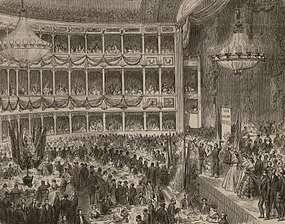Naum Theatre
The Naum Theatre, named after its owners Michel Naum and Joseph Naum of Syrian Catholic background,[1] was a theatre and opera house on İstiklal Avenue in the Beyoğlu (formerly Pera) district of Istanbul, Turkey. It was opened in 1844 and remained active until the theatre building was severely damaged by the Fire of Pera in 1870.[1][2] The ruined theatre building was purchased by Ottoman Greek banker Hristaki Zoğrafos Efendi, who built the present-day Çiçek Pasajı on its land plot in 1876.[2]
History

The Naum Theatre was originally built as the Bosco Theatre by Italian illusionist Bartolomeo Bosco, on a land plot on İstiklal Avenue owned by the Naum family,[1] as a wooden Ottoman style building.[1] After Bartolomeo Bosco left the city, the ownership of the building passed to Michel Naum and Joseph Naum; who, upon completing the renovation works, reopened it with the name Théatre de Péra in 1844.[1] The first play to be performed in the theatre was the opera play Norma by Vincenzo Bellini.[1]
After this original wooden building suffered damage from fire, a new theatre building was constructed in 1849 and was opened with the name Théatre Italien Naum.[1] The theatre was frequently visited by Sultans Abdülaziz and Abdülhamid II, and hosted Giuseppe Verdi's play Il Trovatore before the opera houses of Paris.[2] The majority of the opera plays that were performed at the Naum Theatre were composed by Vincenzo Bellini, Gaetano Donizetti and Gioachino Rossini.[1] In a letter to his mother, Gustave Flaubert wrote that he watched a play by Donizetti at the Naum Theatre in Istanbul the day following his arrival to the city.[1]
Michel and Joseph Naum were the sole owners in Istanbul of the rights to display many European theatre and opera plays, and brought many foreign troupes to Istanbul.[1] They also printed the first Ottoman Turkish translations of the opera plays in the form of booklets.[1] Apart from the usual evening plays, they also organized daytime plays for groups of viewers coming from the Asian side of the Bosphorus.[1]
Çiçek Pasajı
After the Fire of Pera in 1870, the ruined theatre building was purchased by the local Greek banker Hristaki Zoğrafos Efendi, and architect Kleanthis Zannos designed the current Çiçek Pasajı building, which was constructed in 1876 on the theatre's former land plot.[2]